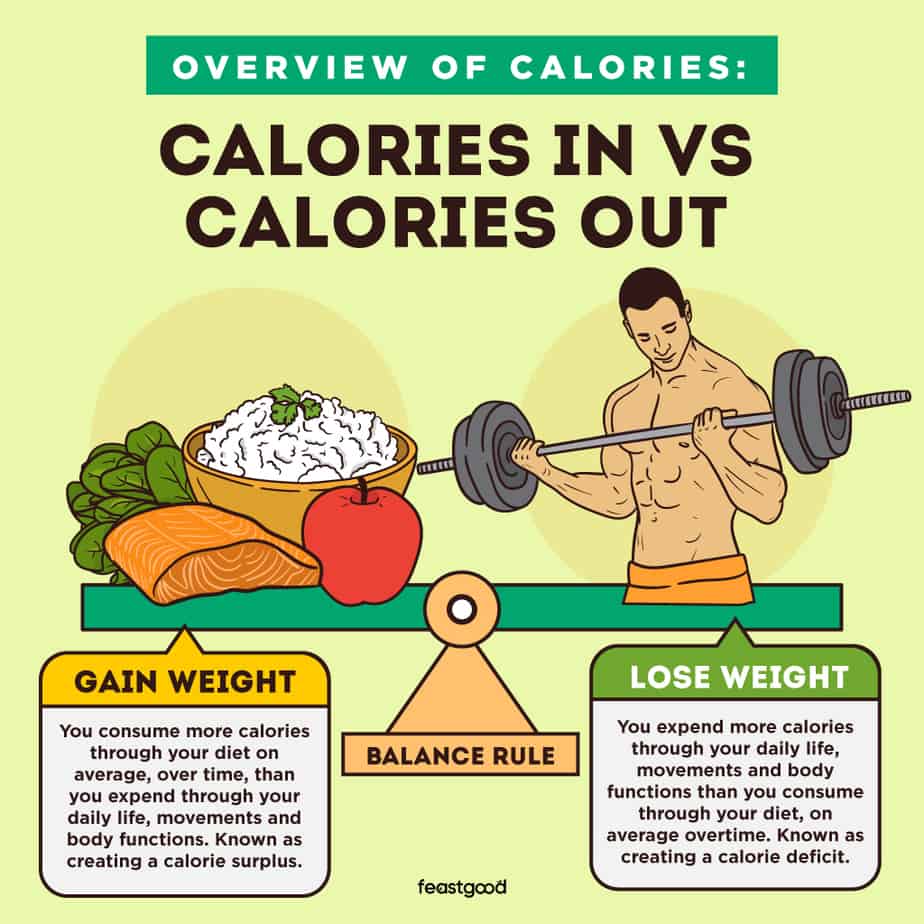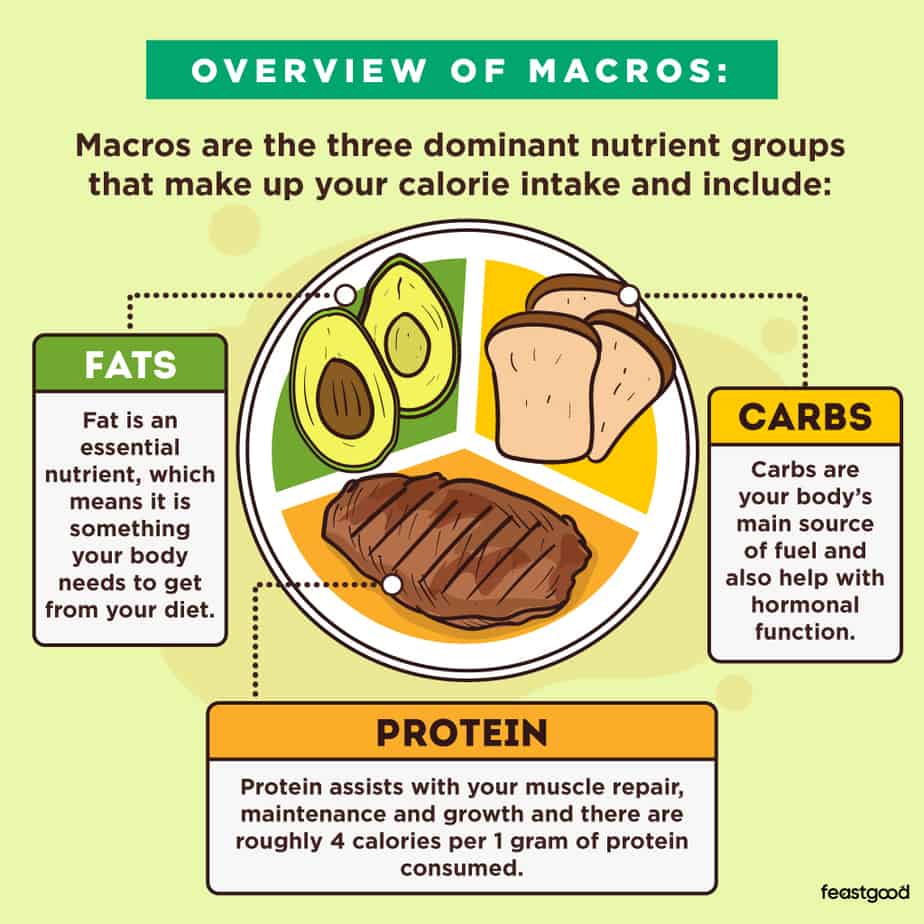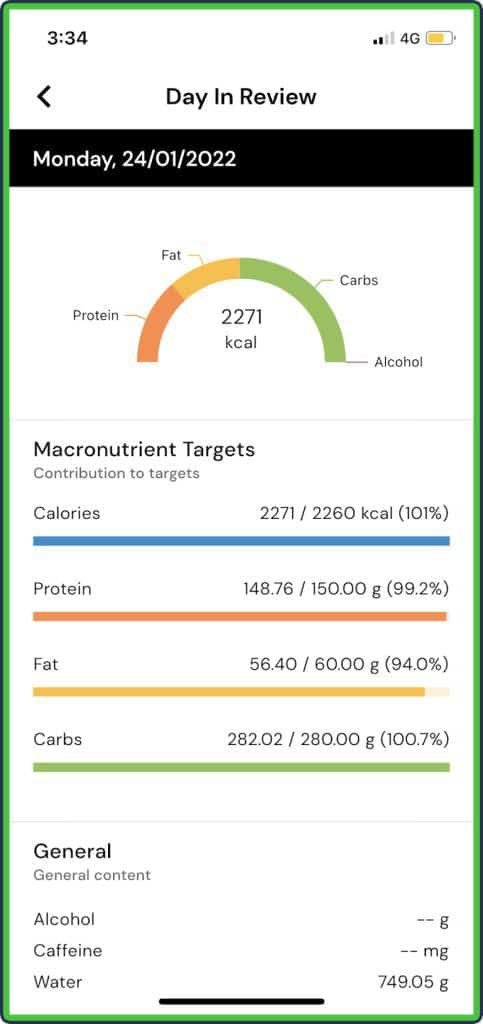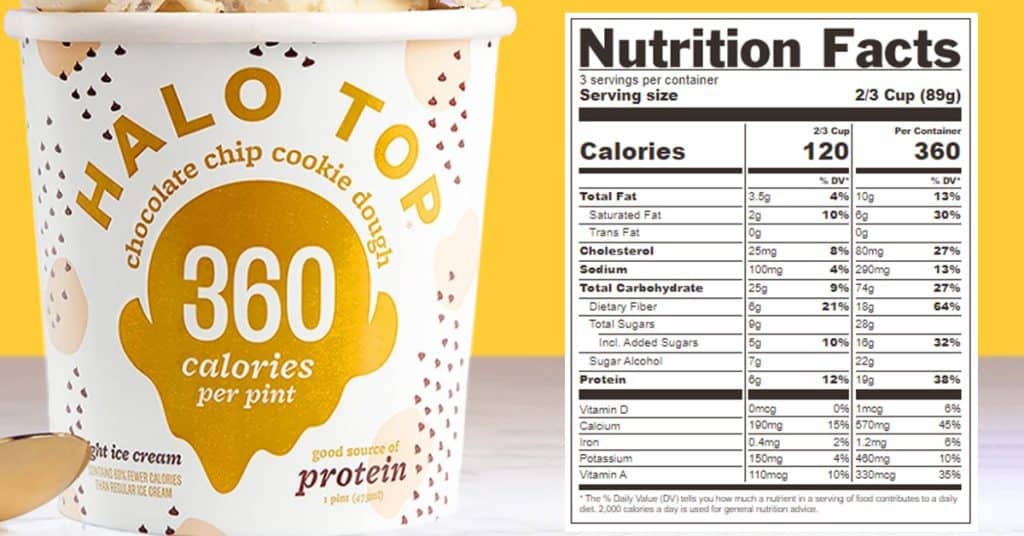Macros are what your calories are made up of, and yet the two don’t always add up, so knowing what to focus on can be confusing.
Is it better to hit your calories or macros? Focusing on hitting your macros will promote more health-seeking behaviors than just focusing on hitting your calories. Each macro group provides your body with different nutrients that play an important role in how your body functions, how you feel, and how you perform.
With that said, it is important to have a view of your overall calorie intake because calorie consumption is still paramount when looking to lose or gain weight and there are certain approaches you can adopt, which can help.
In this article, you learn about:
- The concept of calories in vs calories out
- An overview of macros
- Why calories and macros don’t always add up
- How to make macro and calorie tracking work for you
Check out our complete guide on How To Track Your Macros.
Overview of Calories: Calories in vs Calories Out

Calories in versus calories out are references to the energy balance equation. It is what you need to be mindful of to influence change in your body composition.
To manipulate your body composition to:
- Lose weight, you expend more calories through your daily life, movements and body functions than you consume through your diet, on average overtime. Known as creating a calorie deficit.
- Gain weight, you consume more calories through your diet on average, over time, than you expend through your daily life, movements and body functions. Known as creating a calorie surplus.
To influence changes in your body it must follow the calories in versus calories out, energy balance rule. There will be certain external factors that may make this harder for some people to achieve than others, but the rule remains nonetheless.
- Related Article: Should You Weigh Food Raw or Cooked When Tracking Macros?
Overview of Macros: Carb, Protein, & Fat

While calorie intake has an impact on whether you gain or lose weight, macros will influence whether the weight loss is fat or the gain is muscle, as well as affecting how you feel and perform.
Macros are the three dominant nutrient groups that make up your calorie intake and include:
- Protein
- Carbs
- Fats
Protein
Protein assists with your muscle repair, maintenance, and growth and there are roughly 4 calories per 1 gram of protein consumed.
How much protein you consume will depend on your body weight and whether or not you are in a cutting or bulking phase. When cutting your protein range should be between 2.2 to 2.6 grams of protein per kilo of body weight compared to bulking where it is more likely to be between to 1.6 to 2.2 grams. Regardless of a goal, I’d suggest a good starting point for most is 2.2 grams of protein per kilo of body weight.
Just note, where you may be considered extremely overweight or carrying a lot of body fat compared to lean mass, your protein intake to weight ratio may need to be adjusted.
- See my article about protein for more information.
Carbs
Carbs are your body’s main source of fuel and also help with hormonal function. Your muscles prefer using carbs as their primary source of energy when exercising and to maintain your training quality.
There are 4 calories per 1 gram of carb and as a general rule, the minimum amount of carbs you should consume is around 1 gram per kilo of body weight.
- See my article about carbs for more information.
Fats
Fat is an essential nutrient, which means it is something your body needs to get from your diet.
Fats assist with regular hormonal function, are a fuel source for the body and should always be a part of your diet.
There are 9 calories per 1 gram of fat and the minimum fat intake recommended for most people is 0.5g per kilo of body weight.
- See my article about fats for more information.
Why Calories & Macros Don’t Match Up When Tracking?
When you are tracking calories and macros you may have seen discrepancies between the calories you manually calculate based on your macro intake compared to calorie totals from food labels and database entries.
It might look something like this:
Calorie target = 2,260
Calories tracked in the app = 2,271
Calories based on manual calculation of macros = 2,224.
• Protein: 148*4 = 592 calories
• Carbs: 282*4 = 1,128 calories
• Fat: 56*9 = 504 calories
• Total = 2,224.
The app is telling me I am over on my calories but my manual calculation is telling me I am under. So, what gives?

There are a few reasons why you may experience these discrepancies. The main culprits usually are:
- How you are using your tracking app
- How your tracking app works
- Rules around food and drug administration
How You Are Using Your Tracking App
When you’re using an app to track your food and calorie intake, be wary of the food inputs you are using to actually track your calorie intake.
Food inputs in your tracking app database can often be added incorrectly and then when you go to log them, they will show values inconsistent with the food you are selecting. This will certainly lead to discrepancies in your macro and calorie tracking comparisons.
When in doubt check your country’s food standards database which will give you a good guide on general nutritional content for most foods.
It is also common to scan a barcode into your app and blindly accept the nutritional values that appear. This will not always be accurate. When you are scanning barcodes, make sure the values that appear in your app match up to what is written in the nutritional panel on the food item.
- Related Articles: Best Single Macro Foods (Complete List + PDF Download) and Counting Calories vs Counting Macros: Which Is Better?
How Your Tracking App Works
Tracking apps like MyFitnessPal typically round their macro calculations up. This may not always be visible and could be attributed to discrepancies in macro versus calorie tracking.
This is one of the reasons why I like using an app like MacroFactor to track my calories and macros. The macro calculations are more accurate (rather than rounding), and they have a much wider food database. You can read my review of MacroFactor here.
- Related Aricle: Calories On Rest Days: 7 Rules To Follow (With Sample Plan)
Rules Around Food and Drug Administration
Where things get a bit gray is around food standard authorities and differing expectations from country to country around what needs to be included on food nutritional panels.
Common discrepancies that occur from country to country are:
- There are differing opinions on whether fiber calories should be included in your overall calorie count because of how the body processes and digests them.
Some schools of thought say that fiber calories don’t count, others try to separate different fiber types and assign them calorie values.
With countries approaching fiber differently, what appears on food nutrition labels and how calories are counted will be inconsistent, which will lead to variables in how food is captured in tracking app databases.
Getting too caught up in the numbers can be a trap and the best advice is to either count fiber as a carb and include in your calories or don’t count it and don’t include it. Picking a path and being consistent is the most important thing.
- Sugar alcohols in products – these are the sugar free sweeteners in products and can range from 2.6 calories to almost zero calories per serve. Sugar alcohols will count toward your carbs but similar to fiber may not be reflected in overall calorie count.
Here’s an example to illustrate what I mean:

This product is advertised as containing 360 calories per tub.
However, the macro breakdown and manual calorie count per tub would roughly be:
• Carbs: 74g x 4 calories = 296 calories from carbs
• Protein: 19g x 4 calories = 76 calories from protein
• Fat: 10g x 9 calories = 90 calories from fat
The total manual calorie count would then roughly be around 462 calories per tub (not 360).
The discrepancy in this scenario is from fiber and sugar alcohols being included in the manual calorie count.
In contrast, the product values exclude those fiber and sugar alcohols in the calories count but do include them in the carb count.
This shows how a product’s nutrition label can create a disparity between your macros and calories not adding up.
While these discrepancies may seem like a lot, they are largely negligible in the grand scheme of things. Obsessing over getting your numbers technically correct isn’t what is going to yield results in the long run.
Focus on consistently eating within your protein, fat, and carb ranges in the context of overall calories and you’ll see progress.
- Related Article: How To Count Calories Without Getting Obsessed (5 Tips)
Should You Hit Your Macros Or Calories?
Aiming to hit your macros will promote a balanced approach to your nutrition and encourage you to make more health-seeking decisions around your diet.
Macros are the primary food groups your calories come from, provide different nutrients to your body, and have a dramatic influence on how you feel and perform. By aiming to hit your macros you’re more likely to:
- Provide your body with the nutrition it needs to support your goals
- Consume a balanced diet
- Support your bodily function to perform optimally so you are feeling your best
In contrast, by only focusing on calories, while you may be achieving your calorie deficit or surplus goals you’re less likely to be providing your body with what it needs from a health point of view, because you are only looking at your nutrition from a weight loss or gain point of view.
- Related Article: Calorie Surplus vs Calorie Deficit: What Are The Differences?
How To Make Macro & Calorie Tracking Work For You?
Calorie and macro tracking go hand in hand, and while it is important to focus on macros, that doesn’t mean you disregard your calorie consumption altogether, because as discussed above when trying to influence changes in your body composition the energy balance equation still matters.
You probably aren’t 4 weeks out from a bodybuilding pro international competition, and so absolute rigidity around nutrition and consumption is not necessary for your goals and relevant to your sport or lifestyle. You don’t need to make your nutrition difficult. Suffering doesn’t not equate to success.
Tracking macros should provide you with balance and flexibility in the pursuit of your goals. A practical approach is to view your calories and macros as ranges instead of firm set targets.
This will look something like having:
- A set calorie range with a mix of macro targets and minimums. For example 2,500 to 2,700 calories with a protein target of 180g, a fat minimum of 50g and a carb minimum of 250g; or
- A set target for your calories and macros but setting a tolerance for each of them. For example a tolerance might be going over or under your calories by 100 and going over or under your macros by 10g.
Each of those approaches can be tailored to your individual needs while still:
- Allowing you to work toward hitting your macros
- Having an awareness of calories
- Preventing you from frussing over the numbers too much.
Related Article: Can You Lose Fat Eating Maintenance Calories?
Frequently Asked Questions:
What Happens If I Don’t Hit My Macros When Bulking?
If you are consistently not hitting your protein target but still eating in a surplus, you’ll find yourself more likely to put on fat than muscle. If you are looking to bulk, the most important macro is protein. Your other macro intake is less important providing you maintain a calorie surplus on average, over time.
What Happens If I Don’t Hit My Macros When Cutting?
If you’re missing your macros when cutting but you’re still consistently in a calorie deficit overtime, then you’ll still lose weight. However, by regularly missing your macros you could be losing muscle instead of fat and make managing your appetite cues more difficult because you aren’t getting a balance of food.
Other Macro Tracking Articles
- Lean Bulk Macros: How To Calculate (The Proper Way)
- How To Increase Protein Intake Without Increasing Your Fat
- I Burned More Calories Than I Ate & Still Gained Weight (Why)
- How To Count Calories Without Labels (4 Ways)
- How To Count Calories Without Getting Obsessed (5 Tips)
- Do Macros Matter for Bulking? (Yes, Here’s Why)
- Gaining Muscle Without Counting Calories or Macros (7 Tips)
- 50-30-20 Macros: What Is It, How It Works, & Sample Meals
- Does Eating Junk Food After A Workout Ruin It? (No, Here’s Why)
Final Thoughts
Remember, nutrition is more than body weight manipulation. By understanding your body’s needs you’re not only more likely to achieve your body composition goals but you maintain them while feeling healthier and more informed.
Learning about macros is a great tool in understanding how your body works and what it needs to function and perform optimally while achieving body composition goals more effectively.
About The Author

Steph Catalucci is an online nutrition coach from Australia, working with clients all over the world. Her passion for nutrition was born through wanting to treat her body better, for health and performance. She is a strong advocate for understanding nutrition to develop informed nutritional habits that go beyond just food. Steph leverages a decade of her own nutritional experience to help people make sense of the noise and carve a path forward with their nutrition, supporting clients with whatever body composition goal they have. When not coaching or writing, you’ll find her training for her next powerlifting competition.
Why Trust Our Content

On Staff at FeastGood.com, we have Registered Dietitians, coaches with PhDs in Human Nutrition, and internationally ranked athletes who contribute to our editorial process. This includes research, writing, editing, fact-checking, and product testing/reviews. At a bare minimum, all authors must be certified nutrition coaches by either the National Academy of Sports Medicine, International Sport Sciences Association, or Precision Nutrition. Learn more about our team here.
Have a Question?
If you have any questions or feedback about what you’ve read, you can reach out to us at [email protected]. We respond to every email within 1 business day.

